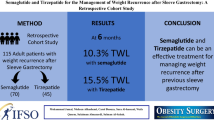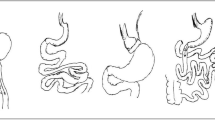Abstract
Background
This study aims to assess the effect of laparoscopic Roux-en-Y gastric bypass (LRYGB) on body composition, fat distribution, and insulin resistance (IR) in Chinese type 2 diabetes mellitus (T2DM) patients.
Methods
Eighteen patients with T2DM were studied before and 3 months post LRYGB. Fasting plasma glucose (FPG), fasting insulin (FINS), and triglyceride (TG) were measured. IR index was determined using the homeostasis model assessment of insulin resistance (HOMA-IR). Body composition and fat distribution were measured by dual-energy X-ray absorptiometry (DXA). Fat mass (FM), muscle mass (MM), bone mineral content (BMC), and percent fat mass (%FM) at the whole body and five body regions including the arms, legs, trunk, android, and gynoid were obtained from DXA scans.
Results
HOMA-IR decreased from 5.02 at baseline to 1.43 3 months post LRYGB (p < 0.05). There was significant decrease in total and regional body mass and body fat (all p < 0.05). A significant reduction was observed in %FM at every tested body region (all p < 0.05). There was more fat mass loss (31.03 %) in android region than any other tested body region. Preoperative android %FM was significantly correlated with IR (r = 0.49, p < 0.05). Changes in android FM showed significant correlations with changes in IR, FPG, FINS, and TG (r = 0.54, 0.64, 0.54, and 0.67, respectively; all p < 0.05).
Conclusions
Body composition in Chinese T2DM patients is rebalanced after LRYGB. Reduction of central obesity can result in improvement of IR, and android fat distribution may be a good indicator of postoperative benefits for LRYGB.
Similar content being viewed by others
Abbreviations
- IDF:
-
International diabetes federation
- ADA:
-
American Diabetes Association
- LRYGB:
-
Laparoscopic Roux-en-Y gastric bypass
- T2DM:
-
Type 2 diabetes mellitus
- IR:
-
Insulin resistance
- HOMA-IR:
-
Homeostasis model assessment of insulin resistance
- LNIR:
-
Natural logarithm of HOMA-IR
- BMI:
-
Body mass index
- WC:
-
Circumference of the waist
- WHR:
-
Waist to hip ratio
- OGTT:
-
Oral glucose tolerance test
- FPG:
-
Fasting plasma glucose
- FINS:
-
Fasting insulin
- TG:
-
Triglyceride
- DXA:
-
Dual-energy X-ray absorptiometry
- FM:
-
Fat mass
- MM:
-
Muscle mass
- BMC:
-
Bone mineral content
- BW:
-
Body weight
- %FM:
-
Percent fat mass
- A/G:
-
Android to gynoid ratio in %FM
- %Change:
-
Percentage of change
- SAT:
-
Subcutaneous adipose tissue
- VAT:
-
Visceral adipose tissue
References
Danaei G, Finucane MM, Lu Y, et al. National, regional, and global trends in fasting plasma glucose and diabetes prevalence since 1980: systematic analysis of health examination surveys and epidemiological studies with 370 country-years and 2.7 million participants. Lancet. 2011;378(9785):31–40.
Yang W, Lu J, Weng J, et al. Prevalence of diabetes among men and women in China. N Engl J Med. 2010;362(12):1090–101.
de Aquino LA, Pereira SE, de Souza SJ, et al. Bariatric surgery: impact on body composition after Roux-en-Y gastric bypass. Obes Surg. 2012;22(2):195–200.
Schauer PR, Ikramuddin S, Gourash W, et al. Outcomes after laparoscopic Roux-en-Y gastric bypass for morbid obesity. Ann Surg. 2000;232:515–29.
DeMaria EJ, Sugarman HJ, Kellum JM, et al. Results of 281 consecutive total laparoscopic Roux-en-Y gastric bypasses to treat morbid obesity. Ann Surg. 2002;235:640–5.
Shah M, Simha V, Garg A. Review: long term impact of bariatric surgery on body weight, comorbidities, and nutritional status. J Clin Endocrinol Metabol. 2006;91(11):4223–31.
Zhu L, Mo Z, Yang X, et al. Effect of laparoscopic Roux-en-Y gastroenterostomy with BMI < 35 kg/m2 in type 2 diabetes mellitus. Obes Surg. 2012;22(10):1562–7.
Lear SA, Humphries KH, Kohli S, et al. Visceral adipose tissue accumulation differs according to ethnic background: results of the multicultural community health assessment trial (M-CHAT). Am J Clin Nutr. 2007;86(2):353–9.
Bays H, Ballantyne C. Adiposopathy: why do adiposity and obesity cause metabolic disease? Future Lipidol. 2006;1(4):389–420.
Alberti KG, Zimmet P, Shaw J. The metabolic syndrome—a new worldwide definition. Lancet. 2005;366(9491):1059–62.
Janssen I, Katzmarzyk PT, Ross R. Waist circumference and not body mass index explains obesity-related health risk. Am J Clin Nutr. 2004;9:379–84.
Bigaard J, Frederiksen K, Tjønneland A, et al. Waist circumference and body composition in relation to all-cause mortality in middle-aged men and women. Int J Obes (Lond). 2005;29:778–84.
Carey DG, Jenkins AB, Campbell LV, et al. Abdominal fat and insulin resistance in normal and overweight women: direct measurements reveal a strong relationship in subjects at both low and high risk of NIDDM. Diabetes. 1996;45:633–8.
Rosenthal AD, Jin F, Shu XO, et al. Body fat distribution and risk of diabetes among Chinese women. Int J Obes Relat Metab Disord. 2004;28(4):594–9.
Montague CT, O'Rahilly S. The perils of portliness: causes and consequences of visceral adiposity. Diabetes. 2000;49:883–9.
Nestel P, Lyu R, Low LP, et al. Metabolic syndrome: recent prevalence in east and Southeast Asian populations. Asia Pac J ain Nutr. 2007;16(2):362–7.
He Y, Zhai F, Ma G, et al. Abdominal obesity and the prevalence of diabetes and intermediate hyperglycaemia in Chinese adults. Public Health Nutr. 2009;12:1078–84.
Chen CM. Overview of obesity in Mainland China. Obes Rev. 2008;9:14–21.
Wat NM, Lam TH, Janus ED, et al. Central obesity predicts the worsening of glycemia in southern Chinese. Int J Obes Relat Metab Disord. 2001;25(12):1789–93.
Xi B, Liang Y, He T, et al. Secular trends in the prevalence of general and abdominal obesity among Chinese adults, 1993–2009. Obes Rev. 2012;13(3):287–96.
Hu G, Qiao Q, Tuomilehto J, et al. Plasma insulin and cardiovascular mortality in non-diabetic European men and women: a meta-analysis of data from eleven prospective studies. Diabetologia. 2004;47:1245–56.
Choi K, Kim YB. Molecular mechanism of insulin resistance in obesity and type 2 diabetes. Korean J Intern Med. 2010;25:119–29.
Balkau B, Charles MA, Drivsholm T, et al. Frequency of the WHO metabolic syndrome in European cohorts, and an alternative definition of an insulin resistance syndrome. Diabetes Metab. 2002;28:364–76.
Lakdawala M, Bhasker A. Report: Asian consensus meeting on metabolic surgery. Recommendations for the use of bariatric and gastrointestinal metabolic surgery for treatment of obesity and type II diabetes mellitus in the Asian population. Obes Surg. 2010;20(7):929–36.
Janssen I, Shields M, Craig CL, et al. Prevalence and secular changes in abdominal obesity in Canadian adolescents and adults, 1981 to 2007–2009. Obes Rev. 2011;12:397–405.
Huettner F, Rammos CK, Dynda DI, et al. Body composition analysis in bariatric surgery: use of air displacement plethysmograph. Am Surg. 2012;78(6):698–701.
Glickman SG, Marn CS, Supiano MA, et al. Validity and reliability of dual energy X-ray absorptiometry for the assessment of abdominal adiposity. J Appl Physiol. 2004;97:509–14.
Kaul S, Rothney MP, Peters DM, et al. Dual-energy X-ray absorptiometry for quantification of visceral fat. Obesity (Silver Spring). 2012;20(6):1313–8.
Rothney MP, Xia Y, Wacker WK, et al. Precision of a new tool to measure visceral adipose tissue (VAT) using dual-energy X-ray absorptiometry (DXA). Obesity (Silver Spring). 2013;21(1):E134–6.
Liu Y, Xiong J, He H, et al. Visfatin level after laparoscopic Roux-en-Y gastric bypass surgery in patients with type 2 diabetes. Zhong Nan Da Xue Xue Bao Yi Xue Ban. 2013;38(3):258–61.
Miller GD, Carr JJ, Fernandez AZ. Regional fat changes following weight reduction from laparoscopic Roux-en-Y gastric bypass surgery. Diabetes Obes Metab. 2011;13(2):189–912.
Jia WP, Lu JX, Xiang KS, et al. Prediction of abdominal visceral obesity from body mass index, waist circumference and waist-hip ratio in Chinese adults: receiver operating characteristic curves analysis. Biomed Environ Sci. 2003;16(3):206–11.
Vega GL, Adams-Huet B, Peshock R, et al. Influence of body fat content and distribution on variation in metabolic risk. J Clin Endocrinol Metab. 2006;91(11):4459–66.
Ng AC, Wai DC, Tai ES, et al. Visceral adipose tissue, but not waist circumference is a better measure of metabolic risk in Singaporean Chinese and Indian men. Nutr Diabetes. 2012;2(8):e38.
Smith JD, Borel AL, Nazare JA, et al. Visceral adipose tissue indicates the severity of cardiometabolic risk in patients with and without type 2 diabetes: results from the INSPIRE ME IAA study. J Clin Endocrinol Metab. 2012;97(5):1517–25.
Fox CS, Massaro JM, Hoffmann U, et al. Abdominal visceral and subcutaneous adipose tissue compartments: association with metabolic risk factors in the Framingham Heart Study. Circulation. 2007;116:39–48.
Johansson L, Roos M, Kullberg J, et al. Lipid mobilization following Roux-en-Y gastric bypass examined by magnetic resonance imaging and spectroscopy. Obes Surg. 2008;18(10):1297–304.
Phillips ML, Lewis MC, Chew V, et al. The early effects of weight loss surgery on regional adiposity. Obes Surg. 2005;15(10):1449–55.
Conflict of Interest
The authors declare no conflict of interest.
Author information
Authors and Affiliations
Corresponding author
Rights and permissions
About this article
Cite this article
Li, W., Zhu, L., Mo, Z. et al. Effect of Laparoscopic Roux-en-Y gastric Bypass on Body Composition and Insulin Resistance in Chinese Patients with Type 2 Diabetes Mellitus. OBES SURG 24, 578–583 (2014). https://doi.org/10.1007/s11695-013-1116-7
Published:
Issue Date:
DOI: https://doi.org/10.1007/s11695-013-1116-7




